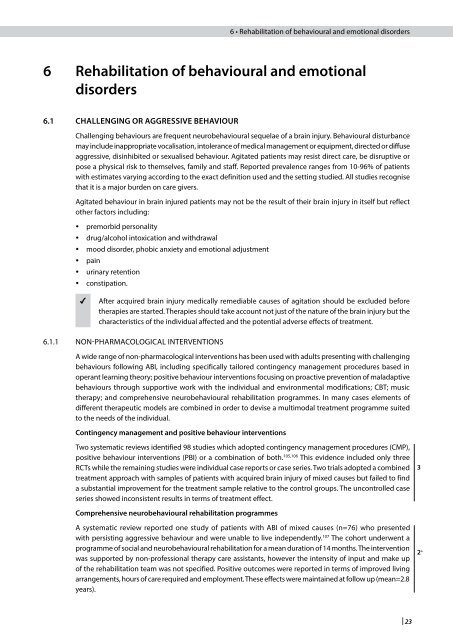sign130
sign130
sign130
Create successful ePaper yourself
Turn your PDF publications into a flip-book with our unique Google optimized e-Paper software.
6 Rehabilitation of behavioural and emotional<br />
disorders<br />
6.1 CHAllENGING oR AGGRESSIVE BEHAVIouR<br />
Challenging behaviours are frequent neurobehavioural sequelae of a brain injury. Behavioural disturbance<br />
may include inappropriate vocalisation, intolerance of medical management or equipment, directed or diffuse<br />
aggressive, disinhibited or sexualised behaviour. Agitated patients may resist direct care, be disruptive or<br />
pose a physical risk to themselves, family and staff. Reported prevalence ranges from 10-96% of patients<br />
with estimates varying according to the exact definition used and the setting studied. All studies recognise<br />
that it is a major burden on care givers.<br />
Agitated behaviour in brain injured patients may not be the result of their brain injury in itself but reflect<br />
other factors including:<br />
y premorbid personality<br />
y drug/alcohol intoxication and withdrawal<br />
y mood disorder, phobic anxiety and emotional adjustment<br />
y pain<br />
y urinary retention<br />
y constipation.<br />
After acquired brain injury medically remediable causes of agitation should be excluded before<br />
therapies are started. Therapies should take account not just of the nature of the brain injury but the<br />
characteristics of the individual affected and the potential adverse effects of treatment.<br />
6.1.1 NON-PHARMACOLOGICAL INTERVENTIONS<br />
A wide range of non-pharmacological interventions has been used with adults presenting with challenging<br />
behaviours following ABI, including specifically tailored contingency management procedures based in<br />
operant learning theory; positive behaviour interventions focusing on proactive prevention of maladaptive<br />
behaviours through supportive work with the individual and environmental modifications; CBT; music<br />
therapy; and comprehensive neurobehavioural rehabilitation programmes. In many cases elements of<br />
different therapeutic models are combined in order to devise a multimodal treatment programme suited<br />
to the needs of the individual.<br />
Contingency management and positive behaviour interventions<br />
Two systematic reviews identified 98 studies which adopted contingency management procedures (CMP),<br />
positive behaviour interventions (PBI) or a combination of both. 105,106 This evidence included only three<br />
RCTs while the remaining studies were individual case reports or case series. Two trials adopted a combined<br />
treatment approach with samples of patients with acquired brain injury of mixed causes but failed to find<br />
a substantial improvement for the treatment sample relative to the control groups. The uncontrolled case<br />
series showed inconsistent results in terms of treatment effect.<br />
Comprehensive neurobehavioural rehabilitation programmes<br />
6 • Rehabilitation of behavioural and emotional disorders<br />
A systematic review reported one study of patients with ABI of mixed causes (n=76) who presented<br />
with persisting aggressive behaviour and were unable to live independently. 107 The cohort underwent a<br />
programme of social and neurobehavioural rehabilitation for a mean duration of 14 months. The intervention<br />
was supported by non-professional therapy care assistants, however the intensity of input and make up<br />
of the rehabilitation team was not specified. Positive outcomes were reported in terms of improved living<br />
arrangements, hours of care required and employment. These effects were maintained at follow up (mean=2.8<br />
years).<br />
| 23<br />
3<br />
2 +


